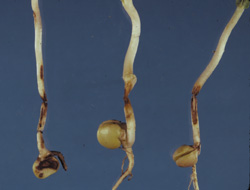
Features
Agronomy
Identity Preserved
Improve lupin and fababean yields with timely weed removal
Weed competition in any crop is a yield robber, but in fababean and narrow leafed lupin it is a thief of the highest order.
November 7, 2008 By Rosalie I. Tennison
Research in Alberta shows well-timed weed control can boost yield in fababean and narrow leafed lupin.
 |
| Lupins benefit from early weed removal. Photo By Bruce Barker. |
Weed competition in any crop is a yield robber, but in fababean and narrow leafed lupin it is a thief of the highest order. Now, research conducted near Barrhead and Lacombe in Alberta shows the timing of grassy weed removal from these two pulse crops make them viable crop choices in an area that traditionally only has success with field peas.
Early grassy weed competition on fababean and narrow leafed lupin reduces crop yield and has prevented these crops from being good choices for growers. However, work completed by Ken Lopetinsky and colleagues at the Agricultural Research Division of Alberta Agriculture and Food proved that early removal of these grassy weeds, particularly cereals and wild oats, can improve yields and promote crop success.
In research conducted during a three year period, seeded barley was used to represent grassy weeds in crops of bean and lupin. Four spray intervals were set at one, two, three and four weeks after the crop emerged. Both high and low water volumes were used with a herbicide registered for grassy weeds. Six sites were seeded for the experiment and during the duration of the research from 2004 to 2006, water volume was not seen to be a factor at any of the sites in terms of efficacy of the weed
control program.
The research proved that the earlier grassy weeds can be removed, the more improved the yield result. The highest yields occurred in fababean when weeds were removed one week after crop emergence, while the lowest fababean yields were seen in four of the six sites when weed control was delayed to four weeks after crop emergence. “Even a competitive pulse crop, like fababean, benefits from early weed removal,” says Lopetinsky. “Some producers are waiting much too long before spraying.”
For narrow leafed lupin, the highest yields were recorded when weeds were removed early. As in the fababean results, the lowest lupin yields occurred when control was completed four weeks after crop emergence. “Lupin is an extremely poor competitor and early and total weed removal is a must to ensure optimum yield potential for this crop,” Lopetinsky explains.
As well, the study looked at dockage in both crops and a determination was made that early weed removal not only reduced dockage, but also resulted in improved seed weight. Lopetinsky concluded that timing of weed removal based on weed emergence may be more important to the success of the crop in terms of yield than timing the weed removal based on crop emergence.
The results of this research make possible the successful production of other pulse crops in the Parkland region of Alberta. Interest in narrow leafed lupin and fababean as alternative crops to field peas has been increasing and Lopetinsky’s research has fine-tuned the weed removal process to encourage better yield and quality. He says growers should apply herbicide soon after the crop emergence stage to achieve higher yield and larger seed weight. “If most of the grassy weeds have germinated, it is time to spray to protect your yield potential,” concludes Lopetinsky.